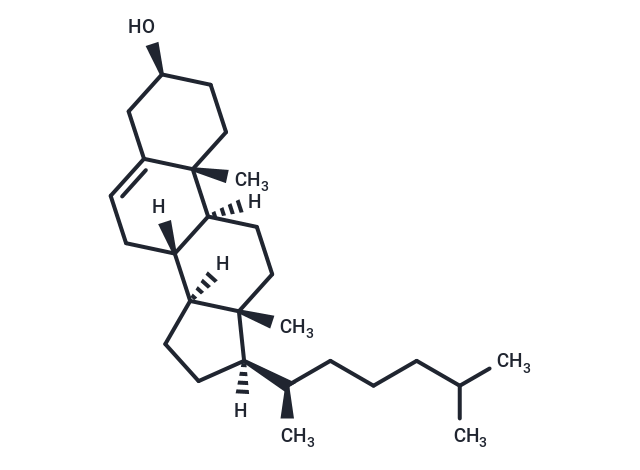Cholesterol [57-88-5]
Cat# NB-64-00922-500mg
Size : 500mg
Cholesterol
Alias Cholesteryl alcohol, Cholesterin
Cholesterol is the primary sterol in mammals, accounting for approximately 20–25% of the plasma membrane structure. It plays a key role in regulating membrane fluidity, permeability, and protein function. As an endogenous agonist of estrogen-related receptor α (ERRα), cholesterol is widely involved in metabolic regulation and serves as a precursor for the synthesis of hormones and bile acids. It is commonly used in experimental models of hyperlipidemia.

Product Introduction
Bioactivity
Chemical Properties
| Description | Cholesterol is the primary sterol in mammals, accounting for approximately 20–25% of the plasma membrane structure. It plays a key role in regulating membrane fluidity, permeability, and protein function. As an endogenous agonist of estrogen-related receptor α (ERRα), cholesterol is widely involved in metabolic regulation and serves as a precursor for the synthesis of hormones and bile acids. It is commonly used in experimental models of hyperlipidemia. |
| In vitro | METHODS: CD4+ T lymphocytes were incubated with 7-KC (17.5-70 µM) and Cholesterol-MβCD (17.5-70 µM) for 10 min, and T cell membrane order and disorder were assessed using di-4 ANEPPDHQ fluorescent dye. RESULTS: After exposure to 7-KC, T cell membrane order was altered in a dose-dependent manner, with significant reconstitution of membrane order observed only in cells treated with 35 µM Cholesterol, while reconstitution with l7.5 µM Cholesterol induced minimal effects. [1] METHODS: Human gastric cancer cells SNU601, SNU638 and SNU216 were treated with Cholesterol (25-100 µM) for 48 h and cell viability was measured using MTT Assay. RESULTS: Cholesterol caused a dose-dependent decrease in cell viability in all three cell lines. [2] |
| In vivo | METHODS: To induce hypercholesterolemia, STD:ddY mice were fed a high cholesterol diet (1% cholesterol, 0.5% cholic acid, 0.5% olive oil and 93% standard mouse chow). RESULTS: Cholesterol can be used to construct a mouse model of hypercholesterolemia. [3] METHODS: To induce hyperlipidemia, CD-1 mice were fed a high cholesterol diet (2% cholesterol and 0.6% sodium deoxycholate). RESULTS: Cholesterol can be used to construct a mouse model of hyperlipidemia. [4] |
| Synonyms | Cholesteryl alcohol, Cholesterin |
| Molecular Weight | 386.65 |
| Formula | C27H46O |
| Cas No. | 57-88-5 |
| Smiles | C[C@@]12[C@]([C@]3([C@@]([C@]4(C)C(=CC3)C[C@@H](O)CC4)(CC1)10)10)(CC[C@@]2([C@@H](CCCC(C)C)C)10)10 |
| Relative Density. | 1.06 g/cm3 |
Storage & Solubility Information
| Storage | store at low temperature,store under nitrogen | Powder: -20°C for 3 years | In solvent: -80°C for 1 year | Shipping with blue ice/Shipping at ambient temperature. | |||||||||||||||||||||||||
| Solubility Information | H2O: < 1 mg/mL (insoluble)  DMSO: < 1mg/mL (insoluble)  Ethanol: 11.42 mg/mL (29.54 mM), Sonication is recommended.  | |||||||||||||||||||||||||
Solution Preparation Table | ||||||||||||||||||||||||||
Ethanol
| ||||||||||||||||||||||||||



